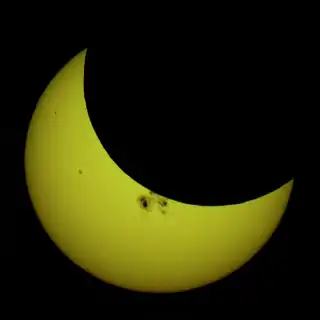| Solar eclipse of January 14, 2029 | |
|---|---|
 Map | |
| Type of eclipse | |
| Nature | Partial |
| Gamma | 1.0553 |
| Magnitude | 0.8714 |
| Maximum eclipse | |
| Coordinates | 63°42′N 114°12′W / 63.7°N 114.2°W |
| Times (UTC) | |
| Greatest eclipse | 17:13:48 |
| References | |
| Saros | 151 (15 of 72) |
| Catalog # (SE5000) | 9571 |
A partial solar eclipse will occur on Sunday, January 14, 2029. A solar eclipse occurs when the Moon passes between Earth and the Sun, thereby totally or partly obscuring the image of the Sun for a viewer on Earth. A partial solar eclipse occurs in the polar regions of the Earth when the center of the Moon's shadow misses the Earth.
Images

Animated path
Related eclipses
Solar eclipses 2026–2029
This eclipse is a member of a semester series. An eclipse in a semester series of solar eclipses repeats approximately every 177 days and 4 hours (a semester) at alternating nodes of the Moon's orbit.[1]
| Ascending node | Descending node | |||||
|---|---|---|---|---|---|---|
| Saros | Map | Gamma | Saros | Map | Gamma | |
| 121 | 2026 February 17 Annular |
−0.97427 | 126 | 2026 August 12 Total |
0.89774 | |
| 131 | 2027 February 6 Annular |
−0.29515 | 136 | 2027 August 2 Total |
0.14209 | |
| 141 | 2028 January 26 Annular |
0.39014 | 146 | 2028 July 22 Total |
−0.60557 | |
| 151 | 2029 January 14 Partial |
1.05532 | 156 | 2029 July 11 Partial |
−1.41908 | |
Partial solar eclipses on June 12, 2029, and December 5, 2029, occur in the next lunar year eclipse set.
Metonic series
The metonic series repeats eclipses every 19 years (6939.69 days), lasting about 5 cycles. Eclipses occur in nearly the same calendar date. In addition, the octon subseries repeats 1/5 of that or every 3.8 years (1387.94 days). All eclipses in this table occur at the Moon's ascending node.
| 21 eclipse events, progressing from south to north between June 10, 1964, and August 21, 2036 | ||||
|---|---|---|---|---|
| June 10–11 | March 27–29 | January 15–16 | November 3 | August 21–22 |
| 117 | 119 | 121 | 123 | 125 |
 June 10, 1964 |
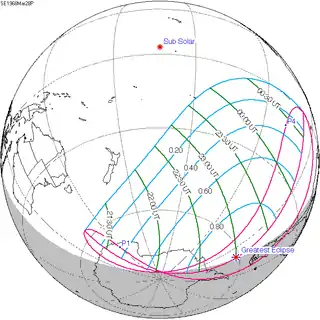 March 28, 1968 |
 January 16, 1972 |
 November 3, 1975 |
 August 22, 1979 |
| 127 | 129 | 131 | 133 | 135 |
 June 11, 1983 |
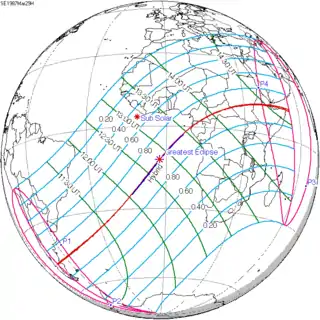 March 29, 1987 |
 January 15, 1991 |
 November 3, 1994 |
 August 22, 1998 |
| 137 | 139 | 141 | 143 | 145 |
 June 10, 2002 |
 March 29, 2006 |
 January 15, 2010 |
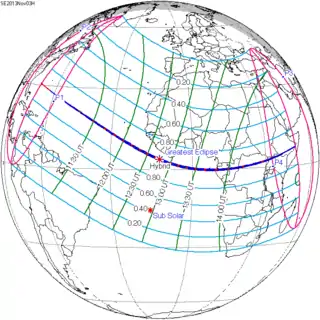 November 3, 2013 |
 August 21, 2017 |
| 147 | 149 | 151 | 153 | 155 |
 June 10, 2021 |
 March 29, 2025 |
 January 14, 2029 |
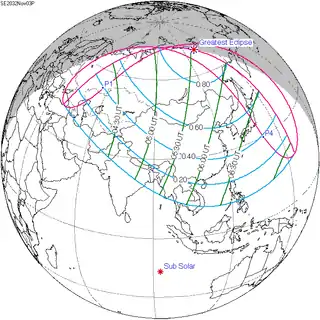 November 3, 2032 |
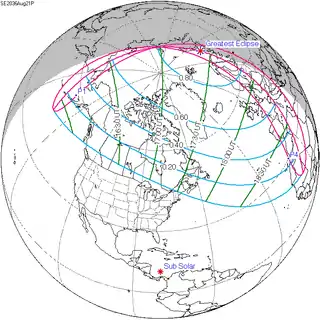 August 21, 2036 |
References
- ↑ van Gent, R.H. "Solar- and Lunar-Eclipse Predictions from Antiquity to the Present". A Catalogue of Eclipse Cycles. Utrecht University. Retrieved 6 October 2018.
External links
- Earth visibility chart and eclipse statistics Eclipse Predictions by Fred Espenak, NASA/GSFC
.jpg.webp)

